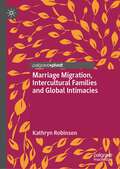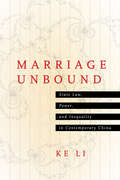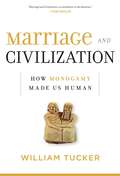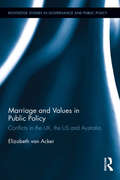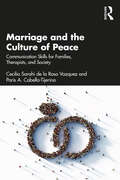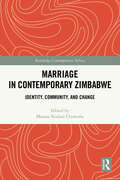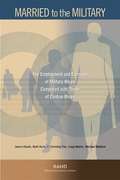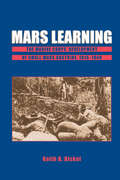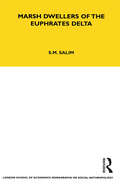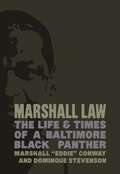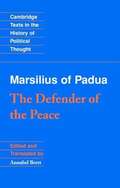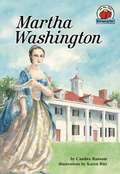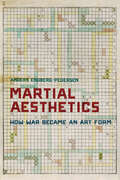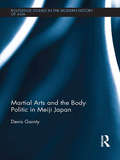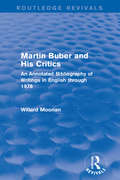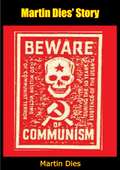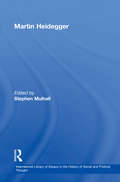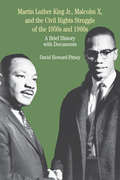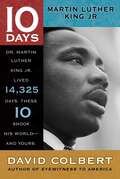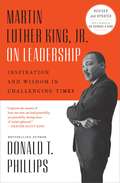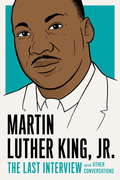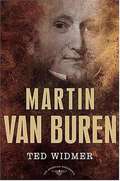- Table View
- List View
Marriage Migration, Intercultural Families and Global Intimacies
by Kathryn RobinsonThis book brings an innovative study of marriage migration in Australia, offering new insights into issues of intimacy and authenticity online. In doing so, it delivers on five main objectives: exploring emotional attachment and personal life in global spaces; interrogating stereotypes and their pervasive influence on personal relations; analysing attitudes and social practice within the institution of marriage; investigating immigration policy, marriage, and citizens’ rights; theorizing gender and class relations in the current global order. The analysis moves between ‘online’ and ‘offline’ social relations and processes, with comparative data enabling a critical framing of the data on marriage relationships developed online. This important contribution places contemporary forms of transcultural marriage and marriage brokering in a historical context of ‘marriage’ in the ‘Anglosphere’ tradition, and in particular historical forms of marriage migration in settler colonial and now multicultural Australia—including histories of colonial era ‘bride ships’ and post WW2 ‘proxy brides’ from southern Europe.
Marriage Unbound: State Law, Power, and Inequality in Contemporary China
by Ke LiChina after Mao has undergone vast transformations, including massive rural-to-urban migration, rising divorce rates, and the steady expansion of the country's legal system. Today, divorce may appear a private concern, when in fact it is a profoundly political matter—especially in a national context where marriage was and has continued to be a key vehicle for nation-state building. Marriage Unbound focuses on the politics of divorce cases in contemporary China, following a group of women seeking judicial remedies for conjugal grievances and disputes. Drawing on extensive archival and ethnographic data, paired with unprecedented access to rural Chinese courtrooms, Ke Li presents not only a stirring portrayal of how these women navigate divorce litigation, but also a uniquely in-depth account of the modern Chinese legal system. With sensitive and fluid prose, Li reveals the struggles between the powerful and the powerless at the front lines of dispute management; the complex interplay between culture and the state; and insidious statecraft that far too often sacrifices women's rights and interests. Ultimately, this book shows how women's legal mobilization and rights contention can forge new ground for our understanding of law, politics, and inequality in an authoritarian regime.
Marriage and Civilization: How Monogamy Made Us Human
by William TuckerWilliam Tucker documents the historical and anthropological story behind how monogamous, lifelong partnerships are the driving force behind the creation and rise of civilization.
Marriage and Values in Public Policy: Conflicts in the UK, the US and Australia (Routledge Studies in Governance and Public Policy)
by Elizabeth van AckerMarriage is a site of political conflict. It is a controversial issue in the UK, Australia and the US where there is a clash of values between neoliberal governments and diverse groups either strongly opposing or supporting marriage. In the meantime, fewer couples are marrying, while other family forms are more widely accepted. This book explores this disconnect by examining policy issues such as class divides, ethnicity, religion, same-sex marriage, gender relations and romantic expectations. A top down approach explores different government policy responses to marriage. In all three countries, there are differences and similarities in how governments react to the changes in family formations, but values or ‘conceptions of the desirable’ play a significant role. Enhancing stability and commitment as well as personal responsibility are important for policymakers who aim to keep ‘the family’ intact and thereby lower the burden on the public purse. It is difficult for political actors to respond to conflicting and changing values surrounding the diversity in relationships or to translate them into policies. There is a strong case to be made for increased policy attention to adult relationships - and a much weaker case for marriage. Rich evidence is drawn from interviews with key stakeholders as well as politicians’ speeches, government departmental reports, stakeholders’ documents and responses to government policies, and media articles.
Marriage and the Culture of Peace: Communication Skills for Families, Therapists, and Society
by Cecilia Sarahi de la Rosa Vazquez Paris A. Cabello-TijerinaThis book provides skills for therapists and families to help improve interpersonal communication, promoting a new system of family coexistence and a refreshed concept of the modern marriage in society. Written from a constructivist peace perspective, the book’s aim is to reduce the high statistics of intimate partner violence that occurs in Mexico, arguing that the culture of peace and how it is born in the family in turn affects society for better or for worse. Based upon interviews from 150 long-term married couples, the chapters address the components that promote peaceful dialogue in marriages, such as assertive language, active listening, tolerance to frustration, and gender perspectives. Including accessible language and several models of peace, the book uniquely examines same-sex marriages, the role of children in marriage conflicts, and prescribed gender assumptions and roles in relationships. It aims to empower family members to move away from old habits and seek a more equitable existence in marriages and society at large. This interdisciplinary text will be of great interest to family therapists and clinical social workers, as well as to students and researchers in communication and peace studies.
Marriage in Contemporary Zimbabwe: Identity, Community, and Change (Routledge Contemporary Africa)
by Manase Kudzai ChiwesheMarriage has always occupied a profound cultural and social significance in Zimbabwean society, but the forms and meanings attached to marriage have changed in recent decades. Marriage in Contemporary Zimbabwe provides a social analysis of the institution, highlighting how it is changing and evolving in the face of societal factors such as globalisation, technology, increased migration, religious plurality, and shifting cultural systems.This book traces the evolution of Zimbabwean marriages from traditional pre-colonial customs into the diverse modern practices seen today. Drawing on rich qualitative insights from across urban, rural, and diaspora communities, it explores the shift in traditional ascribed gender roles, and the complex negotiations between persisting tradition and emerging modern influences. These influences include women’s empowerment, partner choice, and divorce. It explores changes in childrearing and the dissolution of the extended family networks that once governed marriages and provided mutual support. The book also explores broader societal transformations such as urban migration and westernisation, and the impact of socioeconomic challenges such as HIV/AIDS, COVID-19, poverty, and economic hardship.Students and scholars of Zimbabwean history, culture, gender, and the family will find this book essential for understanding the continuities and evolutions of the marriage institution in Zimbabwe.
Married to the Military: The Employment and Earnings of Military Wives Compared with Those of Civilian Wives
by Craig Martin C. Christine Fair James Hosek Beth J. Asch Michael MattockFocusing on military wives' contribution to family income, the authors find that, in contrast to civilian wives, military wives are willing to accept lower wages rather than search longer for jobs. They work less than civilian wives if they have young children but more if their children are older; are less probable to work as they get older; and respond to changes in the unemployment rate as workers with a permanent attachment to the work force, not as "added workers."
Mars Architecture: Construction 6.0 for Designing Sustainable and Health-Oriented Habitats
by Amjad Almusaed Ibrahim Yitmen Asaad AlmssadThis book combines Construction 6.0 with AEC principles for designing sustainable, health-focused Martian habitats. It unveils innovative architectural designs ideal for Mars, utilizing 3D printing, autonomous robotics, and regolith, alongside renewable energy and life support systems. With an emphasis on well-being, it integrates biophilic design and digital technologies to enhance operational efficiency. Exploring various habitat models, it advocates a multidisciplinary approach to extraterrestrial colonization that balances technological advancement with environmental and ethical stewardship, aiming to make human life on Mars a healthy and sustainable reality.
Mars Learning: The Marine Corps' Development Of Small Wars Doctrine, 1915-1940
by Keith B. BickelKeith B. Bickel challenges a host of military and strategic theories that treat particular bureaucratic structures, large organizations, and elites as the progenitors of doctrine. This timely study of how the military draws lessons from interventions focuses on the overlooked role that mid-level combat officers play in creating military doctrine. Mars Learning closely evaluates Marine civil and military pacification operations in Haiti, the Dominican Republic, and Nicaragua, and illuminates the debates surrounding the development of Marine Corps' small wars doctrine between 1915 and 1940. The result is compelling evidence of how field experience obtained before 1940 played a role in shaping the Marine Corps' Small Wars Manual and elements of doctrine that exist today. How the Marines organized lessons at that time provides important insights into how doctrine is likely to be generated today in response to post-Cold War interventions around the globe.
Marsh Dwellers of the Euphrates Delta (LSE Monographs on Social Anthropology #Vol. 23)
by S. M. SalimDr Salim, of Bagdad University, spent two years amongst the remarkable tribal peoples who inhabit the great marshes of the lower Euphrates. He describes their social and economic organization and discusses on the one hand the process by which people with bedouin traditions and values have adapted themselves to different and difficult conditions, and on the other the effects upon them of submission to the central government and the modernisation of their modes of life that has resulted from it. His account offers a fascinating study of people living in an unusual environment, and will be of value to the anthropologist and ethnologist for its precise ethnography. At the same time, as one of the few detailed studies of the changes now being wrought on such a large scale by modern economic and political forces, it has real importance for the general student of contemporary Middle Eastern affairs.
Marshall Law
by Dominque Stevenson Marshall Eddie" ConwayIn 1970 the feds framed Marshall "Eddie" Conway for the murder of a Baltimore city police officer. He was twenty-four years old. They threw him in prison; took him away from his family, his friends, and his organizing; and tried to relegate him to a life marked by nothing but legal appeals, riots and lockdowns, and transfers from one penal colony to the next. But they failed.Forty years later, still incarcerated for a crime he didn't commit, Eddie Conway continues to resist. Marshall Law is a poignant story of strength and struggle. From his childhood in inner-city Baltimore to his political awakening in the military, from the rise of the Black Panther Party to the sham trial, the realities of prison life, escape attempts, labor organizing on the inside, and beyond, Eddie's autobiography is a reminder that we all share the responsibility of resistance, no matter where we are.Marshall "Eddie" Conway is the former minister of defense of the Baltimore Black Panther Party. In 1969 he uncovered evidence of the FBI's infiltration of the Panthers as a part of the COINTELPro initiative, and found himself locked away just one year later, convicted of a murder he did not commit. Currently in his fortieth year of incarceration in a Maryland correctional facility, he has played a leading role in a variety of prisoner support initiatives, including the formation of the Maryland chapter of the United Prisoner's Labor Union and the ACLU's Prison Committee to Correct Prison Conditions.
Marsilius of Padua at the Intersection of Ancient and Medieval Traditions of Political Thought
by Vaileios SyrosThis book focuses on the reception of classical political ideas in the political thought of the fourteenth-century Italian writer Marsilius of Padua. Vasileios Syros provides a novel cross-cultural perspective on Marsilius's theory and breaks fresh ground by exploring linkages between his ideas and the medieval Muslim, Jewish, and Byzantine traditions.Syros investigates Marsilius's application of medical metaphors in his discussion of the causes of civil strife and the desirable political organization. He also demonstrates how Marsilius's demarcation between ethics and politics and his use of examples from Greek mythology foreshadow early modern political debates (involving such prominent political authors as Niccolò Machiavelli and Paolo Sarpi) about the political dimension of religion, church-state relations, and the emergence and decline of the state.
Marsilius of Padua: The Defender of the Peace
by Annabel Brett'The Defender of the Peace of Marsilius of Padua' is a massively influential text in the history of western political thought. Marsilius offers a detailed analysis and explanation of human political communities, before going on to attack what he sees as the obstacles to peaceful human coexistence.
Martha Washington ((On my own biography))
by Candice RansomMartha Dandridge Custis was twenty-seven years old when she married George Washington. She worked by her husband's side to help keep their family, home, and country running smoothly. Whether she was at a ball or on a battlefield, Martha Washington set the standard for all future First Ladies with her quiet determination and courage.
Martial Aesthetics: How War Became an Art Form
by Anders Engberg-PedersenThe twenty-first century has witnessed a pervasive militarization of aesthetics with Western military institutions co-opting the creative worldmaking of art and merging it with the destructive forces of warfare. In Martial Aesthetics, Anders Engberg-Pedersen examines the origins of this unlikely merger, showing that today's creative warfare is merely the extension of a historical development that began long ago. Indeed, the emergence of martial aesthetics harkens back to a series of inventions, ideas, and debates in the eighteenth and early nineteenth century. Already then, military thinkers and inventors adopted ideas from the field of aesthetics about the nature, purpose, and force of art and retooled them into innovative military technologies and a new theory that conceptualized war not merely as a practical art, but as an aesthetic art form. This book shows how military discourses and early war media such as star charts, horoscopes, and the Prussian wargame were entangled with ideas of creativity, genius, and possible worlds in philosophy and aesthetic theory (by thinkers such as Leibniz, Baumgarten, Kant, and Schiller) in order to trace the emergence of martial aesthetics. Adopting an approach that is simultaneously historical and theoretical, Engberg-Pedersen presents a new frame for understanding war in the twenty-first century.
Martial Arts and the Body Politic in Meiji Japan (Routledge Studies in the Modern History of Asia)
by Denis GaintyIn 1895, the newly formed Greater Japan Martial Virtue Association (Dainippon Butokukai) held its first annual Martial Virtue Festival (butokusai) in the ancient capital of Kyoto. The Festival marked the arrival of a new iteration of modern Japan, as the Butokukai’s efforts to define and popularise Japanese martial arts became an important medium through which the bodies of millions of Japanese citizens would experience, draw on, and even shape the Japanese nation and state. This book shows how the notion and practice of Japanese martial arts in the late Meiji period brought Japanese bodies, Japanese nationalisms, and the Japanese state into sustained contact and dynamic engagement with one another. Using a range of disciplinary approaches, Denis Gainty shows how the metaphor of a national body and the cultural and historical meanings of martial arts were celebrated and appropriated by modern Japanese at all levels of society, allowing them to participate powerfully in shaping the modern Japanese nation and state. While recent works have cast modern Japanese and their bodies as subject to state domination and elite control, this book argues that having a body – being a body, and through that body experiencing and shaping social, political, and even cosmic realities – is an important and underexamined aspect of the late Meiji period. Martial Arts and the Body Politic in Meiji Japan is an important contribution to debates in Japanese and Asian social sciences, theories of the body and its role in modern historiography, and related questions of power and agency by suggesting a new and dramatic role for human bodies in the shaping of modern states and societies. As such, it will be valuable to students and scholars of Japanese studies, Japanese history, modern nations and nationalisms, and sport and leisure studies, as well as those interested in the body more broadly.
Martin Buber and His Critics (Routledge Revivals): An Annotated Bibliography of Writings in English through 1978
by Willard MoonanFirst published in 1981. Martin Buber has been acclaimed as one of the major philosophical and religious thinkers of the twentieth century with his influence and achievements spanning numerous fields — however in each of these areas his work has also been severely criticised and his influence called into question. This volume brings together in a systematic arrangement all the significant material by and about Martin Buber published in English up to the centenary of his birth in 1978. To make the bibliography as useful as possible, the critical material was annotated and various indexes were constructed, including an extensive subject index to both Buber’s works and the criticism.
Martin Dies’ Story
by Martin DiesIn this shocking book leading anti-communist Martin Dies reveals the revelations that he uncovered in his quest to rid American of socialism.“In the seven years during which I headed the Special Committee on Un-American Activities of the House of Representatives, the so-called Dies Committee, I heard a great deal of truth that is still not generally known to the American public. Whatever the reason may be for this ignorance, the time has come when the story that I know so well needs to be told.“Few are left who know the entire story, and fewer still who know it firsthand. Some lips have been sealed by death, others by fear, and some by possible economic sanctions, or for other reasons sufficient to themselves. This is a silence I have decided to break.” (Martin Dies)<
Martin Heidegger (International Library of Essays in the History of Social and Political Thought)
by Stephen MulhallAlthough Heidegger's writings are not extensively concerned with the analysis of political concepts or with advocating particular arrangements of political institutions, his basic way of understanding the human relation to the world accords a constitutive significance to its social, cultural and historical dimensions. There is thus a political aspect to his thinking about every philosophical matter to which he turns his attention. This collection of essays is designed to identify, contextualize and critically evaluate the main phases of his intellectual development from that perspective.
Martin Luther King Jr., Malcolm X, and the Civil Rights Struggle of the 1950s and 1960s
by David Howard-PitneyThe civil rights movement’s most prominent leaders, Martin Luther King, Jr. (1929–1968) and Malcolm X (1925–1965), represent two wings of the revolt against racism: nonviolent resistance and revolution "by any means necessary." This volume presents the two leaders’ relationship to the civil rights movement beyond a simplified dualism. A rich selection of speeches, essays, and excerpts from Malcolm X’s autobiography and King’s sermons shows the breadth and range of each man’s philosophy, demonstrating their differences, similarities, and evolution over time. Organized into six topical groups, the documents allow students to compare the leaders’ views on subjects including integration, the American dream, means of struggle, and opposing racial philosophies. An interpretive introductory essay, chronology, selected bibliography, document headnotes, and questions for consideration provide further pedagogical support.
Martin Luther King Jr.: Martin Luther King Jr. (10 Days)
by David ColbertDiscover ten crucial days in the life of activist and civil rights leader Martin Luther King, Jr., in this installment of the 10 Days series.Martin Luther King, Jr., lived 14,325 days, but then of them changed his world—and ours. Follow Dr. King&’s journey from his teenage refusal to give up his bus seat to his famous &“I Have a Dream&” speech that inspired the world. This essential book includes historical black-and-white photographs, a selected bibliography, and an important introduction to the Civil Rights Movement—including the Montgomery bus boycott, the Freedom Rides, and Dr. King&’s time in a Birmingham jail cell.
Martin Luther King, Jr., on Leadership: Inspiration and Wisdom for Challenging Times
by Donald T. PhillipsLeadership motivational speaker Donald T. Phillips, who has previously drawn organizational lessons for modern businesses from the careers of Abraham Lincoln and the Founding Fathers, turns to civil-rights leader Martin Luther King Jr. as a role model. A discussion of the Montgomery bus boycott, for example, draws out such principles as "Set goals and create a plan of action" and "Involve the people." More effective as a self-help book for business than as a biography, it does provide a useful introduction to King's life.
Martin Luther King, Jr.: and Other Conversations
by Martin Luther KingAs the Black Lives Matter movement gains momentum, and books like Ta-Nehisi Coates's Between the World and Me and Claudia Rankine's Citizen swing national attention toward the racism and violence that continue to poison our communities, it's as urgent now as ever to celebrate Martin Luther King, Jr., whose insistence on equality and peace defined the Civil Rights Movement and forever changed the course of American history. This collection ranges from an early 1961 interview in which King describes his reasons for joining the ministry (after considering medicine), to a 1964 conversation with Robert Penn Warren, to his last interview, which was conducted on stage at the convention of the Rabbinical Assembly, just ten days before King's assassination. Timely, poignant, and inspiring, Martin Luther King, Jr.: The Last Interview is an essential addition to the Last Interview series.
Martin Van Buren (The American Presidents Series)
by Arthur M. Schlesinger Ted WidmerThe first president born after America's independence ushers in a new era of no-holds-barred democracy The first "professional politician" to become president, the slick and dandyish Martin Van Buren was to all appearances the opposite of his predecessor, the rugged general and Democratic champion Andrew Jackson. Van Buren, a native Dutch speaker, was America's first ethnic president as well as the first New Yorker to hold the office, at a time when Manhattan was bursting with new arrivals. A sharp and adroit political operator, he established himself as a powerhouse in New York, becoming a U.S. senator, secretary of state, and vice president under Jackson, whose election he managed. His ascendancy to the Oval Office was virtually a foregone conclusion. Once he had the reins of power, however, Van Buren found the road quite a bit rougher. His attempts to find a middle ground on the most pressing issues of his day-such as the growing regional conflict over slavery-eroded his effectiveness. But it was his inability to prevent the great banking panic of 1837, and the ensuing depression, that all but ensured his fall from grace and made him the third president to be denied a second term. His many years of outfoxing his opponents finally caught up with him. Ted Widmer, a veteran of the Clinton White House, vividly brings to life the chaos and contention that plagued Van Buren's presidency-and ultimately offered an early lesson in the power of democracy.
Martin Van Buren: Eighth President Of The United States
by Rafaela EllisTraces the childhood, education, employment, political career, and presidency of the man from Kinderhook, New York.
